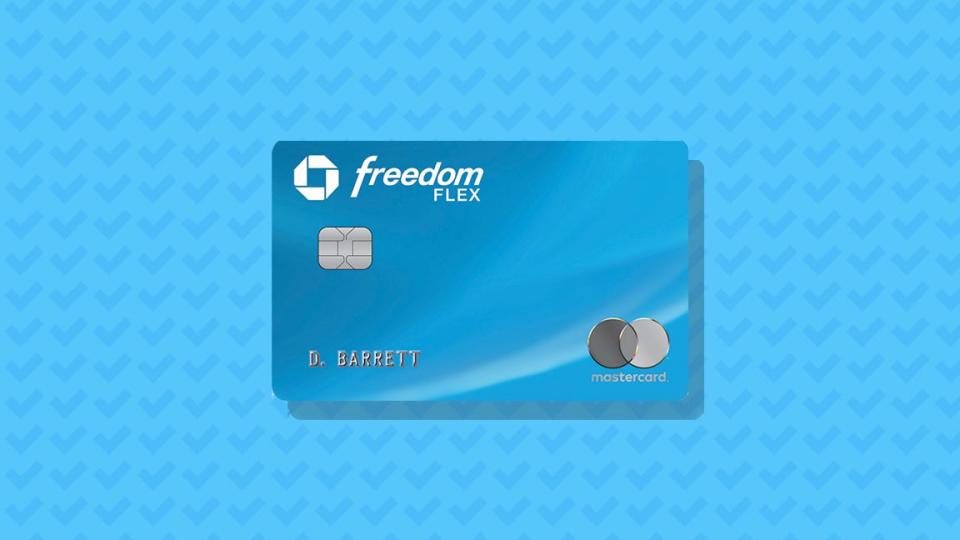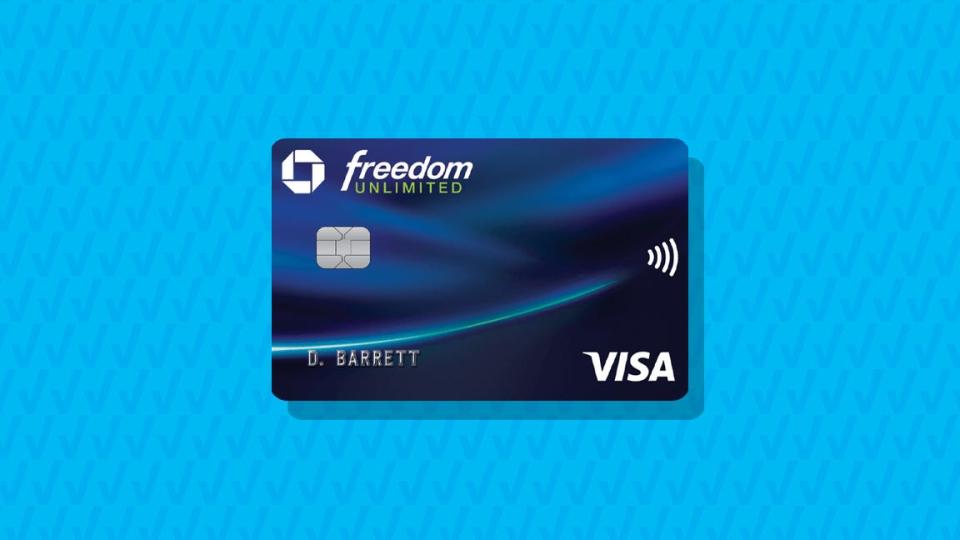Chase's new credit card has big-time benefits without an annual fee

— Our editors review and recommend products to help you buy the stuff you need. If you sign up for a credit card after clicking one of our links, we may earn a small fee for referring you. However, our picks and opinions are independent from USA TODAY's newsroom and any business incentives.
At the end of August 2020, Chase announced the Chase Freedom Flex, a cash-back credit card that has no annual fee. The brand-new card gives you the best of both worlds—there’s a 5% cash-back category that changes every quarter plus three fixed categories that reward spending on travel, dining, and drugstore shopping.
In the world of category credit cards, this combination is pretty unique. Plus, the Chase Freedom Flex card has several introductory offers that may be hard to pass up.
In this review, we break down what the Freedom Flex has to offer to help you decide if it'd be a nice addition to your wallet.
Need help finding products? Sign up for our weekly newsletter. It’s free and you can unsubscribe at any time.

Annual fee: None
Introductory purchase APR: 0% APR for 15 months
Regular APR: 14.99% to 23.74%
Balance transfer APR: 14.99% to 23.74%
Balance transfer fee: 5% or $5, whichever is greater
Points: Earn 5% cash back on the first $1,500 spent in revolving categories each quarter, 5% on travel bookings through Chase Ultimate Rewards, 3% on dining and drugstore purchases, and 1% on all other purchases.
Introductory rewards offer: An additional 4% on Lyft rides through March 2022
Foreign transaction fee: 3%
Learn more about the Chase Freedom Flex
Who should get the Chase Freedom Flex?
The Chase Freedom Flex gives you plenty of opportunities to earn cash back for the bare essentials. According to Chase, the changing quarterly category may offer 5% cash back on groceries, streaming services, gas, utilities, or specific retailers. For example, cardholders will earn the top rewards rate while shopping at Walmart and PayPal October through December.
If you’re not cooking much at home lately, you can rack up 3% on dining and takeout, including certain delivery services. You can also score 3% whenever you hit up the drugstore for personal care items.
If you’re looking for a card with intro offers, the Freedom Flex has plenty of sign-up bonuses and incentives. There’s a 0% APR introductory offer on purchases for the first 15 months—and then a variable APR applies. So, if you want to do a DIY home project or you need to buy a big-ticket item, you could do so on the card and pay it off slowly without having to worry about interest charges.
There's more. As of this publishing, if you spend $500 on purchases within the first three months from account opening, you’ll also earn a $200 cash bonus.
And through March 2022, the card will give you an extra 4% on Lyft rides, so you get a total of 5% back. Cardholders also get a free DashPass for three months. DashPass is DoorDash’s subscription service where you get free delivery on eligible orders. After the free membership expires, you’ll get another nine months of DashPass for 50% off.
What points do you get with the Chase Freedom Flex?

There’s a lot to unpack, so here’s a bulleted list:
5% cash back on the first $1,500 you spend each quarter in the revolving rewards category
5% when you book travel through Chase Ultimate Rewards—e.g., airline tickets, hotel stays, car rentals, activities, and cruises
5% on Lyft rides through March 2022
3% at drugstores
3% on dining (including takeout)
1% on everything else
Cash back earned is tracked in points, and one point is worth one cent. Points never expire as long as your account is open, and you can redeem cash back for cash, gift cards, travel, or products and services through “pay with points.”
What perks do you get with the Chase Freedom Flex?
The Freedom Flex is a Mastercard—the first from Chase in five years—that comes with World Elite Mastercard perks. With Zero Liability Protection, cardholders won’t be held liable for unauthorized purchases.
Purchases you make with the card are also covered for up to 120 days. If an item is damaged or stolen, you can get reimbursed for up to $500 per claim and $50,000 per account.
If you rent a car, you may be covered in the event of a collision or theft. Trip cancellation insurance may also reimburse you for up to $1,500 per person or up to $6,000 per trip if a prepaid trip is cut short or canceled altogether.
The phones on your phone bill are covered up to $800 per claim and $1,000 per year if they are stolen or damaged as long as you pay the bill with the credit card.
How does Chase Freedom Flex compare to other cards?
The Chase Freedom Flex stands out as a card that has revolving categories and fixed categories. You’re probably wondering how it compares to others you can choose from, so let’s discuss:
The Chase Freedom Flex vs. the Chase Freedom Unlimited

Chase also announced changes to the Freedom Unlimited during the unveiling of the Freedom Flex. Until now, the Freedom Unlimited had been a flat-rate card that gave you 1.5% cash back on all purchases with no other rewards categories.
Now on top of the unlimited 1.5% cash back, the Freedom Unlimited will offer 5% on travel through Chase Ultimate Rewards, and 3% cash back at restaurants and drugstores, much like the Freedom Flex.
While Freedom Unlimited cardholders won’t cash in on the rotating 5% categories, one perk is that you earn 1.5% when you shop outside of the bonus categories; meanwhile, the Chase Freedom Flex gives you 1% back for out-of-category shopping.
The Chase Freedom Unlimited currently has some of the same intro perks as the Freedom Flex. For example, you’ll also earn a $200 cash bonus if you spend $500 within the first three months.
The Chase Freedom Flex vs. Discover it®
The Discover it is another popular revolving 5% category card with no annual fee. To earn the top rewards rate, cardholders need to activate the 5% category every quarter, which currently includes grocery stores, gas stations, drugstores, restaurants, PayPal, Amazon, and more. The spending limit for the 5% category is $1,500 per quarter, and you earn 1% on all other purchases.
Discover will match your cash back dollar-for-dollar at the end of the first year, and this is something the Freedom Flex doesn’t have. Right now, there’s also an introductory 0% offer for 14 months on balance transfers and new purchases.
What drawbacks does the Chase Freedom Flex have?
While cardholders will score 5% cash back on travel, the card also has a 3% foreign transaction fee, so it may not be the right card to bring along on a baecation. Since international travel is still down, you may only be making domestic travel plans anyway.
Also, the Freedom Flex doesn’t have a “hands-off” rewards program. You have to activate the 5% revolving rewards category before the deadline to earn category rewards each quarter. Although, you’ll need to take this step with similar cards on the market, too.
Like its competitors, there’s also a $1,500 spending limit on the 5% category for each quarter. This works out to a limit of $500 per month, and that could be low if you shop for a big family. After you surpass that threshold, you only earn 1% cash back.
So, should you get the Chase Freedom Flex?
The Freedom Flex announcement is shaking things up in the revolving category credit card sphere. Now if your shopping doesn’t align with the quarterly category, you can fall back on the fixed rates to maximize rewards. Just remember, you need to activate the 5% revolving category each quarter to participate. We recommend setting some calendar alerts so you don’t miss out.
Learn more about the Chase Freedom Flex
Please note: The offers mentioned above are subject to change at any time and some may no longer be available.
Reviewed has partnered with CardRatings for our coverage of credit card products. Reviewed and CardRatings may receive a commission from card issuers.
Things to know about credit cards
Long introductory period APR rates are only a short-term incentive. Potentially high APR rates snap into effect after the card’s intro period ends, which could cost you a lot in interest if you’ve left your balance unpaid. It’s really important—especially when getting a card for a big purchase—to keep an eye on your finances and keep an eye on the calendar.
APR rates and credit limits vary based on your individual credit. Credit limits and interest rates for each card are determined based on each cardholder's personal situation, so we did not take that information into account when evaluating these cards. Remember to pay your card off in full every month, so you will not be charged interest.
Banks have the final say on who they accept for a credit card. These recommendations were put together with the assumption that applicants would have average credit or above. That being said, banks decide who they will issue credit cards to using criteria including, but not always limited to, an individual's credit score when evaluating each applicant.
Should you pay off your credit card every month?
Whenever possible, it is best to pay your balance in full every month. You’ll avoid interest charges, for one, and you’ll also maintain a low credit utilization ratio. This percentage is calculated by dividing your monthly balance by your total credit line, and experts recommend keeping it at or below 30%.
But we also get that life happens, and sometimes you bring home less bacon than you anticipated, or an unexpected expense rears its pricey head. Whatever you do, make the minimum payment, and make it on time.
If you can’t swing the whole balance but you do have some cash to spare, consider paying a little more than what you have to pay. This will help lower your utilization ratio and keep your credit score in check. We love a good compromise, don’t you?
Why should you check your credit score?
Some of us may deal with our credit score the way we deal with our bank statements. Ignorance can be bliss, but we don’t recommend avoiding either, for the record. Keeping tabs on your credit score will let you know if something needs attention. A sudden drop might mean you missed a payment, or maybe someone else got ahold of your personal information.
You can get monthly updates from issuers—even ones you’re not a cardholder with—and there are a few other ways to stay in the loop, too. Don’t neglect your credit report either, as mistakes can arise there. In fact, as many as one in four have an error that can affect your score. The best news? Staying on top of these details doesn’t cost you any money.
Other credit card reviews
This article originally appeared on Reviewed: Chase Freedom Flex review: Big-time benefits with no annual fee

